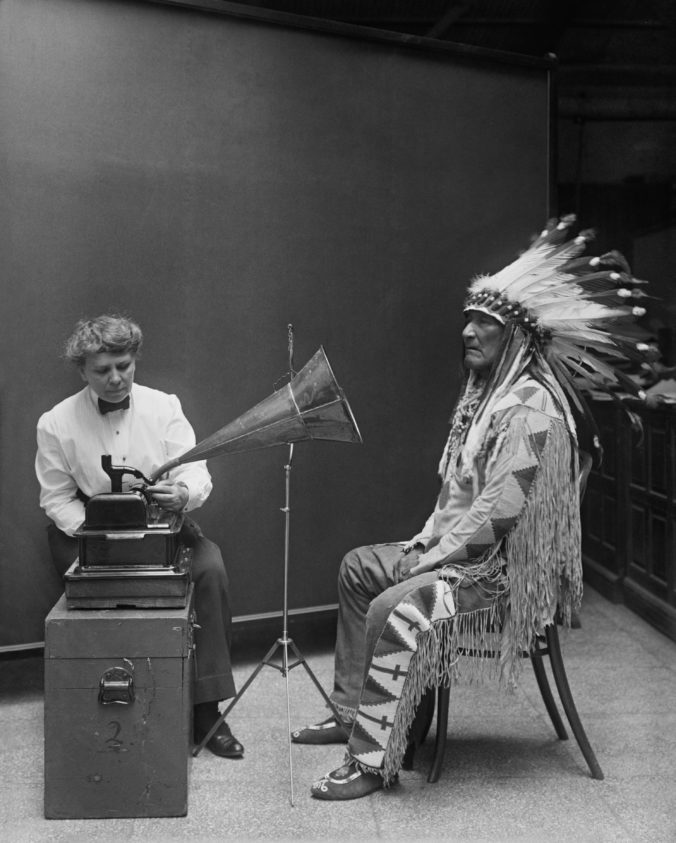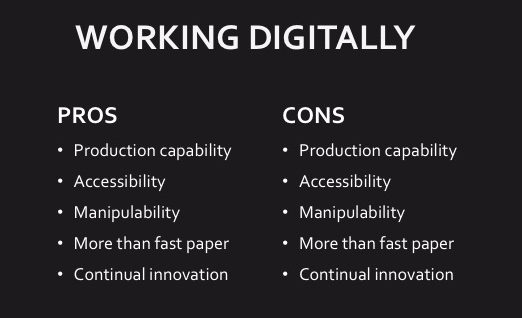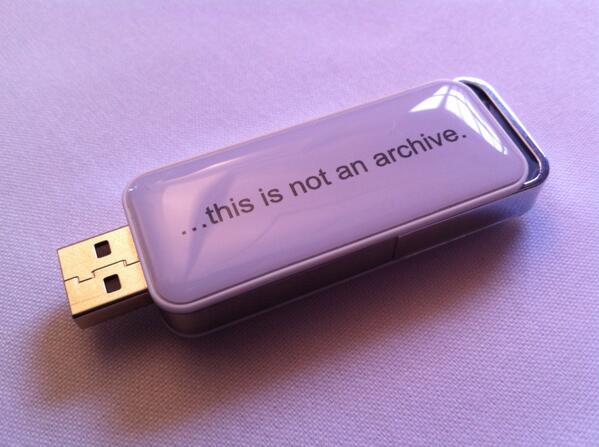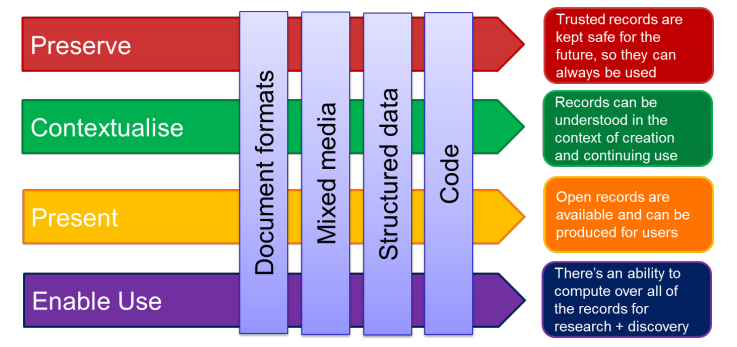On Saturday, 10 June 2017, I was invited to give the keynote at Oral History Victoria’s symposium ‘Oral history in a digital age‘. This post is an edited version of that talk.
A little over a hundred years ago, the ethnographer and anthropologist Frances Densmore sat down with the Blackfoot chief, Mountain Chief. She was capturing Native American music and culture using a phonograph, a device already around 40 years old when this photograph was taken.
In the years since, audio recording technology has continued to evolve – from wire recorders and reel-to-reel magnetic tape machines to the cassette player. The British Library provides a great selection of images covering the history of playback and recording equipment, for those interested in exploring.
But despite rapid technological change, and unlike most material preserved in archives, these machines all had something in common with today: technology was required to ‘translate’ (or access) the informational content they captured. Wax cylinders, wires, tapes and cassettes were, in many senses, the file formats of their day.
Not that this was a cause for concern when it came to preserving oral histories. As some no doubt know, many oral historians in the 1960s were not particularly interested in such things. As Director of the Columbia University Oral History Program Louis Starr once said:
It’s foolish to imagine that it’s going to be worth saving fifty tapes of Francis Perkins. When you want to see exactly how she said it on page two thousand and sixty-three, you’re not going to be able to find that place on the tape for a whole half hour or so. By the time you have, you’ll decide it wasn’t worth the trouble. (quoted in Boyd and Larson, 2014: 2)
Recording devices were an interim step between the interview and the transcription; in many cases, something to be discarded. The transcription was the thing, and it was this that was preserved.
By the time the web was launched, digital audio recording had been around for a number of years. The first DAT (digital audio tape) was introduced by Sony in 1987, and allowed lossless duplication of content for the first time. When combined with the web, some started to speculate on the possibilities, envisioning a world that went far beyond text.
Charles Hardy III summarises these, before outlining his own more modest ambitions:
Prophets of the digital revolution tell us that the World Wide Web (WWW) will create a celestial jukebox of sight and sound that mixes and jumbles wines from previously discrete information carriers; a converging gumbo of written words, still and moving images, sounds, and manipulations; a unified docuverse that reintegrates our senses in a unified three-dimensional sensorium. Citing the utopian hopes that the pioneers of the phonograph, motion pictures, radio, and television placed in these earlier electrical media, skeptics rightly warn us to beware the claims of media hucksters intent on a sale and starry-eyed idealists still holding onto hopes that the Second Coming will arrive in the next new information carrier. So we make no great boasts or promises for our own foray into digital sound. We do, however, ask you to listen to our essay with ears open and eyes closed. (Charles Hardy III, 1999)
The result of Hardy’s work, developed through his collaboration with Alessandro Portelli, was the pioneering work ‘I Can Almost See the Lights of Home,’ which they called an ‘essay-in-sound.’ It brought together elements of oral history and story telling with music, environmental sounds, narration, and other material to produce a soundscape that would be impractical (if not impossible) to produce in an analogue world.
(Despite the changing landscape, Hardy still needed to push the limits of the technology that existed at that time. He writes of editing the piece on a Power Mac in the late 1990s, which required him to export and save completed segments onto seven large external hard drives – each costing around $100 each – to free up space on the primary machine. Today, the whole piece fits easily on a small USB stick.)
All of which brings us to today. We have recorders like the Zoom H5 (which I use for recording interviews), able to record four tracks of broadcast-quality audio for hours at a time. In addition, we have laptops, tablets and smart phones; a plethora of file formats; and the ability to make audio available online to larger audiences than ever before, faster than ever before.
What does this mean for oral historians and others working with recorded sound, media files, or other comparable research data?
I’m not here to give a lecture on the specifics and subtleties of digital archiving (even if it were possible in the time available) but there are some key points of which we all need to be aware. First, to borrow and adapt a slide used as part of the University of Melbourne’s Research Data Management classes, we need to be aware of the pros and cons of working digitally.
We can produce more content, faster, and of a higher quality than ever before. But the problem is the volume of content created is difficult to navigate, use, and manage. Thousands of photographs from an overseas trip might capture more individual moments, but do we do as much with them as people did with a couple of rolls of 36 shots produced using a film camera? When CDs came out, more and more artists started producing albums that were 60-70 minutes long rather than the 45 minutes or so more commonly found on a quality vinyl record; but there is a question as to whether these albums are better, or just longer, or perhaps even suffer as a result of their length. Producing more, longer oral histories brings problems for preservation and management which may outweigh the benefits attained from such work.
The content we do decide to create is now (potentially) more accessible than ever before, which opens up our work to new audiences. But accessibility has negative consequences too. What does it mean for consent given in the pre-internet age, when people had no conception of how visible their recording would be online?
What about oral histories with people who otherwise have no online presence – if their in-depth life story becomes the first and only thing people can find about them online, what impact does this have on privacy? Kelly Anderson, Smith College oral historian, is increasingly reluctant to put the collections “Voices of Feminism” and “Documenting Lesbian Lives” online because some participants have revoked permission after Googling themselves. Anderson says:
The material no longer feels like an archival document with any kind of gatekeeper but rather a trove of personal information available to the masses. (quoted by Sherna Berger Gluck, in Boyd and Larson, 2014: 43)
We can manipulate digital content in ways which sound and appear seamless to anyone but an expert technician, making projects like ‘I Can Almost See the Lights of Home’ easier to complete; but what effect does this have on oral histories as evidence, as records of what a person said at a particular time, in a particular context?
The digital world is about more than ‘fast paper.’ We can include computer code, animation, complex data structures, interactive graphics, augmented and virtual reality, as well as audio, and video, and text. Presenting our work in this way again creates many opportunities, while raising an equal number of challenges for preservation and sustainability, particularly after funded projects have come to an end and our attention is elsewhere.
And, as the brief history introducing this talk shows, we live in an era of continual innovation. Technologies change, along with file formats, preservation practices, and means of dissemination. Software comes and goes, and companies at the top of an industry one decade may slump into obscurity the next.
We therefore need to be conscious of the effects of these pros and cons on our work. Good preservation practice in the digital age requires more than a Zoom recorder, a laptop, and a USB stick.
Learn about file formats and the different options available. Archives are a good source of information here. For example, the National Archives of Australia publishes its preservation file formats online.
Think about what is being preserved. When writing about oral histories, William Schneider said:
The recording is not the original telling; it is an entity derived from the telling. (Schneider, in Boyd and Larson, 2014: 21)
We are preserving a record of an event, not the event itself, with all the limitations and effects of temporal and spatial distance from the moment this entails. (For those interested in finding out more, there is interesting work happening at the moment on the preservation of intangible heritage, performance art, and dance which is worth exploring.)
The fact that future listeners are distanced in this way makes context vitally important. Who is speaking? Who is the interviewer? Where did the interview take place, and what is the context of the recording session(s)? Is the recording done in parts or continuously? What equipment is being used? Have the resulting sound files been edited or processed? Who did the time-coding or transcription? Is it part of a particular project or set of interviews, or stand-alone? The answers to these and similar questions need to be captured and managed along with the audio or video files of the interview to facilitate future use.
It is likely this will involve multiple tools or pieces of software. Whatever you use, have an exit strategy. After ten years VOAHA – the Virtual Oral/Aural History Archive – found the hardware and software they had used initially was no longer viable and needed to migrate all their content to a new site. Make sure you can do the same, taking all your metadata and contextual information with you.
When producing online content, aim to make it sustainable and persistent. If people use your work, they are likely to cite it or link to it directly. Broken links cause a multitude of problems, not just for content creators but for a whole range of ‘downstream’ users.
And finally, think about how the different elements of your work fit together and intersect. The National Archives (UK) released a Digital Strategy in March 2017 which provides a really clear overview of this:
We need to preserve, contextualise, present and enable use of our work, and running through all these phases are different formats and media, structured data, and code. These are the interconnected elements we need to understand to ensure we are preserving our digital content effectively.
Some of you may be looking at all this and thinking the complexity of digital preservation is a burden. But we also need to remember the huge potential of the digital world.
The web has allowed communities to connect in new and exciting ways. People who have been traditionally marginalised or excluded can find a collective voice. For example, the LGBTQ History Digital Collaboratory provides an oral history hub for distributed communities of activists, historians and archivists.
Large institutions like the National Library of Australia (NLA) can make recordings available that help us understand significant social and cultural histories, from stories of Victorian bushfires in 2009 to the experiences of Forgotten Australians and Former Child Migrants. And this work can in turn feed into larger digital and public history projects like the Find & Connect web resource, which utilises and links to oral histories from the NLA.
Digital humanities and related disciplines bring other possibilities. Louise Baker has used visualisation and Social Network Analysis to explore trailblazing women and the law, drawing on oral histories from the project of the same name. Work such as Tim Sherratt’s LODBooks suggest possibilities for linking data about key contextual entities to transcriptions or other text. Augmented reality apps like High Street Stories from quake-affected Christchurch, New Zealand, could incorporate oral history content along with stories, images and other content; and virtual reality could put the listener in the place of the interviewee, immersing them in the moment of the telling.
There is another side to digital humanities too, and one we must not lose sight of in all the excitement of new technologies and floods of data. Deb Verhoeven challenges us to think of the co-creation of the archive and of data; of different forms of practice; of serendipity, and new ways of bridging time and space. How we can interrogate and use data, not (just) to try and represent how things are, but to make a difference? How can technology assist with collective practice, and the contestation of existing ideas and modes of thought?
Miriam Posner also writes of the radical, unrealised potential of digital humanities. One of the examples she gives is of the Changing Face of America, where the complexities of personal and cultural identity is compared to and contrasted with the census boxes people tick. The humanities here re-introduces complexity and uncertainty to a space where big data and data science often obscure the individual, or gloss over the assumptions built into instruments and algorithms.
As people who work in the humanities we need to resist the presumption that we can reach some kind of ‘truth’ if only we can gather more information about more people and process it more quickly. This is the myth of the digital age that personal narratives and storytelling – that the co-creation of individual and community histories – can complicate.
In our complex world this can make something as simple as sitting down in a room with a recording device and someone different to ourselves, then sharing the results of that interaction, profoundly important acts.
References
Boyd, Douglas A., and Mary Larson, eds. Oral History and Digital Humanities: Voice, Access, and Engagement. First edition. Palgrave Studies in Oral History. New York, NY: Palgrave Macmillan, 2014.





1 Pingback